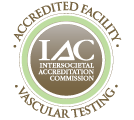The warm weather has finally arrived! You can all put away your winter gear and shed the layers as you welcome the Spring and Summer. Taking out the swimsuits, shorts and sun dresses you get the reminder of those varicose veins you have been meaning to take care of. Yes, you know what I am talking about: those bulging veins, those purple, blue and red clusters of veins. Besides the appearance of the varicose veins, they can sometimes cause burning, throbbing and itching. You are doing your best to get back into shape for the summer, isn’t it time for a new you, with new legs?
Acute deep vein thrombosis or DVT, is a common condition that occurs in the legs of men and women of all ages. It causes leg swelling, pain and can limit walking. The larger the blood clot, the greater the number of veins that are damaged and the more severe are the symptoms.
Free Ultrasound Screenings and Health Seminars Middlesex Hospital Shoreline Medical Center 250 Flat Rock Place Westbrook, CT 06498 Bart Muhs, MD,PhD,FACS Board-Certified Vascular Surgeon The Vascular Experts Board-certified Vascular Surgeon, Bart Muhs will speak about the symptoms, diagnosis and treatment of vascular disease at a series of informative health seminars. Dr. Muhs specializes in the treatment of: aortic aneurysms, carotid disease, PAD, dialysis access, venous diseases and varicose veins. Dr....
In 2010, at age 26, NASCAR driver Brian Vickers was on a trip to Washington DC when he began to experience chest pain. At the time, Vickers was on a meteoric rise as one of the premier drivers in NASCAR. But a condition known as May-Thurner Syndrome was about to put Vickers’ career on hold.
The risk for Abdominal Aortic Aneurysms (AAAs) increases dramatically after the age of 60. As the aneurysms enlarge, they can eventually rupture, and when they do, will almost always result in death. That’s why it is so important to screen for the presence of an AAA, and more so if you have one of the risk factors listed below. Once diagnosed, your healthcare provider will monitor your aneurysms and might suggest that you get it repaired before it reaches a size when it can rupture.
When I was asked to write a blog post about vascular surgery, I had to ask myself: what is it that people want to read about? Perhaps I would ask patients what they are interesting in knowing more about.
One of the most common vascular issues treated by Vascular Surgeons is diabetic foot ulcers (DFUs). Up to 25% of diabetic patients will have a foot ulcer during their lifetime. Diabetic foot ulcers are wounds of the lower extremities that develop because of poor blood circulation.
My Grandmother was an amazing woman. Born and raised in southern Rhode Island she was the classic example of New England grit and vigor.
We live in Connecticut where there is an abundance of natural parks and endless opportunities to engage in recreation. With summer upon us, what better time is there to get outside and enjoy some of the natural beauty Connecticut has to offer?
Just last week the American Heart Association updated their page related to Peripheral Artery Disease (PAD).



